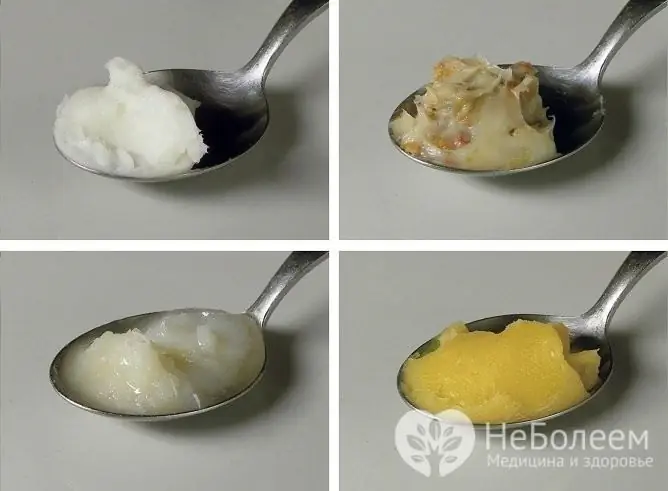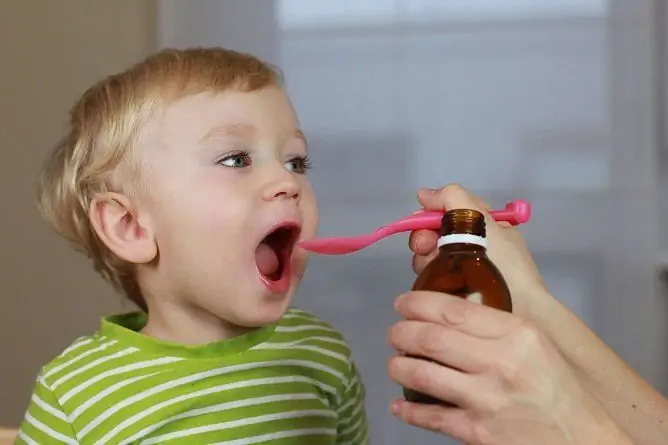- Author Rachel Wainwright [email protected].
- Public 2024-01-15 19:51.
- Last modified 2025-11-02 20:14.
How to cure a child's cough at home
The content of the article:
-
What helps a child cough at home
- Drug therapy
- Inhalation
- Home physiotherapy
-
Traditional methods of treatment
- Phytotherapy
- Milk-based products
- Homemade black radish preparations
- Warming compresses
- Using body fat to treat cough
- Types of cough
- Causes and risk factors
- Video
The answer to the question of how to cure a child's cough at home depends on the cause of its occurrence. Each disease that caused this symptom requires a special approach. For this reason, you should not self-medicate, it is recommended to consult a doctor and be examined.
In most cases, diseases that are accompanied by coughing attacks can be treated at home under the supervision of the attending physician; only in rare cases, the patient needs to be hospitalized. In children, such cases include pneumonia, stenosing laryngotracheitis, and severe forms of bronchitis.

In most cases, cough in children is treated at home, but a doctor must control it.
What helps a child cough at home
Often parents ask the question of how you can treat a child's cough at home quickly. For this, first of all, it is necessary to provide the child with conditions that would facilitate the early resolution of the pathology. The following measures serve this purpose:
- It is necessary to humidify the air in the room where the child is. In humid climates, this can be done by frequent ventilation, in dry climates, using a special device (automatic air humidifier). During the heating season, it is recommended to hang wet towels on the radiators, place several containers of water in the room.
- The room should be regularly ventilated, daily wet cleaning.
- If the baby's condition allows (if the temperature is not increased), you should walk with him in the fresh air.
- For the duration of the illness, exclude from the diet foods that can irritate the mucous membranes of the respiratory tract.
- Provide the child with a plentiful drinking regime, this contributes to better sputum discharge.
Drug therapy
Of the medicines for coughing, depending on the available clinical signs, expectorants, mucolytics, bronchodilators, antitussives, antipyretics, anti-infectious, antihistamines can be prescribed.
Preparations are preferably in the form of syrup and inhalation. A small child is usually not given a lozenge or lozenge because it may swallow or inhale the medicine.
Inhalation
Inhalation has a high antitussive effectiveness, since it allows the active substance to be delivered directly to the inflammation zone. For children, inhalation with a nebulizer is preferable. They are carried out using alkaline mineral water, saline or drug solutions. The doctor prescribes the drug, its dose and frequency of the procedure.

Inhalation with a nebulizer is one of the most effective treatments for cough
Steam inhalation in children is undesirable, moreover, they are ineffective.
Home physiotherapy
In children with some diseases of the respiratory tract, percussion massage is used, which allows sputum to escape better, and breathing exercises, which contributes to the speedy regeneration of tissues.
Traditional methods of treatment
Treatment of a child's cough at home is often carried out using traditional medicine. Alternative therapy cannot replace the main treatment, but can be an effective adjunct to it. Parents should be aware that, contrary to the existing opinion, such treatment is not absolutely safe, therefore, like any other, it requires mandatory agreement with a doctor.
Phytotherapy
Of medicinal plants, the following have an antitussive effect:
- peppermint;
- plantain;
- chamomile medicinal;
- linden flowers;
- clover;
- sage;
- eucalyptus;
- pine buds.
Decoctions and infusions can be made from plant raw materials, used for inhalations.
For example, an infusion of marshmallow, coltsfoot and oregano (in a ratio of 2: 2: 1) is a popular cough remedy for children over 7 years old. Pour 2 tablespoons of the dry mixture into a thermos, pour 500 ml of boiling water and leave for 4 hours. Take ¼ glass 2 times a day.
Milk-based products
The most popular home remedies include milk-based products that reduce irritation to the lining of the larynx and help thin and clear mucus. For the manufacture of medicinal mixtures, you can use cow, goat or other milk with a fat content of at least 2.6%.
- Hot milk with honey. Add 1-2 teaspoons of honey to a glass of milk warmed up to a temperature of 40 ° C; you can also dissolve the same amount of butter in the drink. Warm milk is recommended to be consumed throughout the day and drunk before bedtime, which will help get rid of coughing attacks at night.
- Milk with mineral water. Helps with coughs and sore throat, promotes the discharge of bronchial mucus. To prepare the drink, warm milk and alkaline Borjomi-type mineral water are mixed in equal parts. Mineral water must be vented first.
- Milk with figs. It has a diaphoretic, antipyretic, anti-inflammatory effect. To prepare the medicine, use dark purple or black figs.. 2-4 pieces of fresh figs are poured into a glass of milk, brought to a boil, kept on fire for several minutes and cooled. Before use, dried figs can be poured with cold milk and left for 30 minutes, then bring to a boil and leave for another 20 minutes. Consumed warm, 100 ml 3-4 times a day 30 minutes before meals.
- Milk with butter. Helps relieve a cough attack. To prepare it, dissolve a teaspoon of high quality butter in a glass of warm milk. It is recommended to drink the product before going to bed.
- Milk with cocoa butter. The remedy helps against dry cough. To prepare the medicine, you need to dissolve 0.5 teaspoon of cocoa butter in a glass of hot milk, cool the product a little and give it to the patient to drink.
- Milk with onions. 2 small onions need to be boiled in a glass of milk until softened. After that, the liquid is infused for 4 hours, filtered and given to the patient a tablespoon every 3 hours.
- Milk with ginger. To prepare this drink, grated ginger root (3-4 cm long) and 2 tablespoons of green tea are poured into 1.5 liters of milk, brought to a boil, removed from heat and insisted for about 30 minutes. The product is taken in small sips several times a day.
Homemade black radish preparations
Means, which include black radish juice, have an expectorant effect and are often used for diseases of the respiratory system in children. There are several recipes.
- Add a small amount of sugar to the black radish juice, obtained by any available method. Take 1 teaspoon 4-6 times a day.
- Wash the radish thoroughly, cut off the top and cut out some of the pulp. Honey is placed in the formed recess, leaving room for the juice that stands out. The top is set in place, the radish is left for several hours. The finished product is taken in a teaspoon 3-4 times a day.
- Grind black radish with a grater, squeeze out the juice and mix it with liquid honey in a 1: 1 ratio.
- Cut the radish into slices, place in layers in a suitable container, sprinkle each layer with sugar and leave for several hours to extract juice, which is then drained into a storage container. The remedy is consumed 1 teaspoon several times a day.

Black radish preparations are considered very effective for coughing attacks
Warming compresses
For some illnesses accompanied by coughing (far from all!), You can use warming compresses. Rules for their application:
- When treating children, a compress is placed either on the chest or on the back in one procedure. The location can be alternated every other day.
- The compress should not be applied to the area of the heart and kidneys.
- If the child experiences discomfort during the procedure, the procedure is stopped immediately.
- If, after removing the compress, severe redness of the skin, allergies or other complications are noted, you need to stop using this method and seek medical help.
Contraindications to the use of compresses are the presence of allergies, skin diseases, fever. The method is not used to treat children in the first year of life.
- Potato compress. Boil the potatoes without peeling, knead, add two teaspoons of any vegetable oil to the mass, form a cake and place on the chest or back, then wrap the child with a blanket. Keep the compress until the potatoes cool.
- Mustard and radish compress for older children (after 10 years). Mix 50 g of dry mustard, 50 ml of radish juice, 1 tablespoon of honey, 2.5 cups of water, soak a towel in the mixture, apply it to the body, cover with cellophane and a woolen scarf. The procedure takes no more than 10 minutes. After removing the compress, the skin should be wiped dry, the patient should be wrapped in a blanket.
- Honey compress. Spread honey on the sick child's chest, cover with parchment and wrap the patient. The procedure is recommended to be carried out within 30 minutes. After that, the honey should be wiped off with a damp cloth, the place of exposure can be smeared with a small amount of vegetable oil.
- Compress with salt solution. 90 g of table salt is dissolved in 1 liter of heated water. The cotton fabric is folded in several layers, moistened in a solution, wrung out and applied to the body. Action time - until it cools down (10-20 minutes).
- Mustard compress. Mix 1 tablespoon of mustard powder, flour, vegetable oil and honey, form a cake, place it on the body and keep it for several hours. If the patient complains of severe burning sensation, the procedure should be discontinued.
Using body fat to treat cough
Traditionally, products are used based on internal fat, which is attributed to a particularly powerful antitussive effect. Modern doctors do not share this opinion. Several recipes below are for informational purposes only.
- Badger fat is used for rubbing, and children from 12 years old are allowed to take 1 teaspoon per day (sometimes fat is added to tea or milk). For rubbing, you can use any other internal fat; badger fat has no advantage.
- Goat fat is used for grinding. A mixture of equal parts of fat and honey is taken. They also use a tool for the preparation of which 1 egg yolk is added to 1 glass of warm milk, 1 teaspoon of goat fat and honey, a pinch of sugar. The mixture is consumed up to 3 times a day.
- Goose fat. One lemon is boiled in a small amount of water for 10 minutes, allowed to cool, peeled and squeezed into a broth. Add 2 tablespoons of goose fat to the liquid. The remedy is given to the patient 1 tablespoon before meals.
- Pork fat. 200 g of melted interior pork fat is mixed with the same amount of liquid honey, 100 g of butter, 2 tablespoons of cocoa powder. The drug is given to the patient 1 teaspoon 3-4 times a day, adding the mixture to a glass of warm milk.
Rubbing is not applied at elevated body temperature.

Various fat rubbing is popular for coughing, but its therapeutic effect is questionable
Types of cough
Cough is one of the most common reasons for seeking medical attention. If the cough is not properly treated, it can bother the patient for a long time, and the pathological process will progress. The table shows the main types of coughs, depending on the duration.
| Type of cough | Explanation |
| Acute | No more than 2 weeks |
| Protracted | 2 weeks to 1 month |
| Subacute | 1 to 2 months |
| Chronic | More than 2 months |
In addition, depending on the presence or absence of phlegm, the cough can be dry or moist (wet).
Causes and risk factors
The most common causes of cough include respiratory infections, as well as inflammatory diseases of the respiratory system (laryngitis, pharyngitis, bronchitis, pneumonia, tracheitis, etc.). Cough seizures can be observed in patients with bronchial asthma, tuberculosis, cancer of the respiratory tract, whooping cough.
Cough can be accompanied by diseases of the gastrointestinal tract, pathology of the thyroid gland, cardiovascular system, helminthic invasions. Teens may have a psychosomatic cough caused by stress or intense anxiety.
Also, this symptom can be observed when:
- the presence of an allergic reaction;
- hypothermia of the body;
- inhalation of cigarette smoke, dusty or too dry air, chemicals;
- ingress of foreign bodies into the respiratory tract.
Small babies can cough when teething or swallowing large amounts of breast milk during feeding.
Video
We offer for viewing a video on the topic of the article.

Anna Aksenova Medical journalist About the author
Education: 2004-2007 "First Kiev Medical College" specialty "Laboratory Diagnostics".
Found a mistake in the text? Select it and press Ctrl + Enter.






